#garlic seeds
Explore tagged Tumblr posts
Text

#garlic#seeds#seed#agriculture#backyard#gardening#garden#fruit#vegetables#herbs#herb#foods#foodie#foodporn#food photography#foodgasm#food#ausgov#politas#auspol#tasgov#taspol#australia#fuck neoliberals#neoliberal capitalism#anthony albanese#albanese government#sesame seeds#chia seeds
65K notes
·
View notes
Text
Flavorful Harvests Await: Discover Premium Garlic for Sale in Alberta at Keep Dreamin' Farms
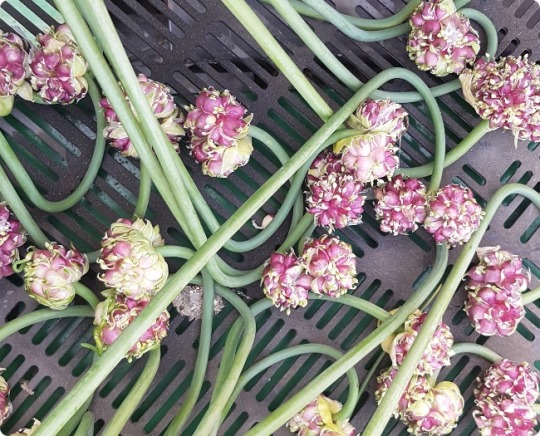
Embracing the Essence of Garlic
Garlic, well-known for its distinctive scent and flavor, is a key ingredient in kitchens around throughout the world. From adding flavor to food items to enhancing overall health and well-being. This pliable bulb provides richness and depth to recipes for cooking. We at Keep Dreamin' Farms, are committed to the industry of garlic and we're committed to supplying the highest quality garlic for Sale Alberta that is grown in our beautiful fields and then delivered fresh at your door.
A Bounty of Garlic Varieties
At Keep Dreamin' Farms, we believe in cultivating a wide varieties of garlic, each with a distinct flavor profiles and culinary attributes. You can select between the hot, spicy notes of Rocambole garlic. Or, the the more delicate sweeter, less flavorful sour notes from Porcelain garlic. We offer a variety of garlic varieties that will satisfy your every taste preferences. Our dedication to high-quality and premium quality ensures that each garlic bulb we select is bursting with flavor and freshness.
Sustainably Grown, Responsibly Harvested
"In Keep Dreamin'' Farms" believe in the importance of sustainable farming and responsible stewardship of our land. This is why we concentrate on organic and sustainable farming practices as well as organic cultivation methods to ensure the sustainability and health for our crop of garlic. From water and soil health conservation, to the conservation of ecosystems and biodiversity We're committed to protecting the natural resources that support future generations as well as us.
From Farm to Table: Freshness Guaranteed
If you purchase fresh garlic from Keep Dreamin Farms, you can rest assured that you are getting the best quality, fresh garlic accessible. Our garlic is picked at a time when it's at its peak of quality, then carefully selected to ensure the best flavor and quality. We are determined to control quality and along with our attention to each aspect. We make sure that every bulb of garlic you purchase is of top quality and tastes.
Elevate Your Culinary Creations
Whatever your skill level, whether you're a professional chef or home cook, our best garlic varieties will take your cooking skills to new heights. From classic pasta dishes to soups with a savory flavor and marinades, sauces, sauces, and sauces There are endless possibilities in cooking using our wonderful garlic. With its deep, complex flavor and aroma, garlic adds richness and flavor to any dish, making every food experience memorable.
Discover the differences Stay Dreamin' Farms
If you're a lover of cooking with the finest ingredients, check out Keep Dreamin' Farms for the most exquisite garlic from Alberta. With our commitment to high-quality, sustainable and delicious We're determined to provide you with the best and best tasting garlic readily available. Explore the potential that our garlic will add to your kitchen, and take your food preparations to new levels of taste.
Mike Davisis the author of this article. To know more about Organic Garlic Alberta please visit our website: https://keepdreamin.ca
Address: 210005 Hwy 519, Picture Butte, AB T0K 1V0, Canada Phone: 403-715-7401 Website: https://keepdreamin.ca/
0 notes
Text

Best Garlic Seeds for Sale in Ontario - Healthy Cloves Garlic Company
Transform your garden with Healthy Cloves Garlic Company's exceptional seed garlic for sale Ontario. Whether you're a garlic enthusiast or a farmer looking to expand your vegetable patch, our diverse selection of high-quality cloves has you covered.
0 notes
Text
Just found out garlic cant grow without a seed because ‘wE hUmAnS arTIfIcIaLlY mOdiFiED iT’
Bull shit
Hate to see this misinformation spread
It was the vampires.
They’re trying to prevent more garlic from growing.
Reblog to spread real information
0 notes
Text
sooo... I tried to buy seeds from a planter in Forgotten Hollow (at the Vatore House) and didn't have the option to buy garlic or mosquito trap seeds. But in my home lot in Oasis Springs I can...!
Can you NOT buy garlic in the vampire world?! 👀
1 note
·
View note
Text
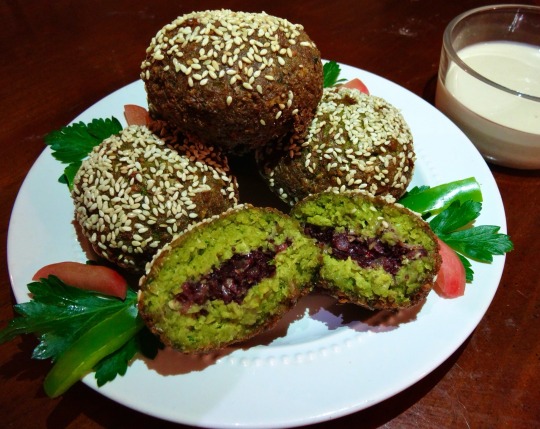
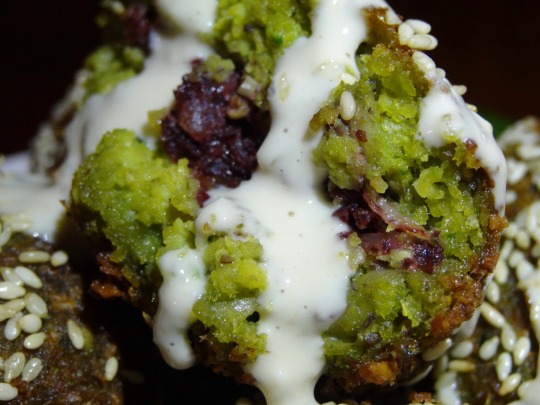
[ID: First image shows large falafel balls, one pulled apart to show that it is bright green and red on the inside, on a plate alongside green chilis, parsley, and pickled turnips. Second image is an extreme close-up of the inside of a halved falafel ball drizzled with tahina sauce. End ID]
فلافل محشي فلسطيني / Falafel muhashshi falastini (Palestinian stuffed falafel)
Falafel (فَلَافِل) is of contested origin. Various hypotheses hold that it was invented in Egypt any time between the era of the Pharoahs and the late nineteenth century (when the first written references to it appear). In Egypt, it is known as طَعْمِيَّة (ṭa'miyya)—the diminutive of طَعَام "piece of food"—and is made with fava beans. It was probably in Palestine that the dish first came to be made entirely with chickpeas.
The etymology of the word "falafel" is also contested. It is perhaps from the plural of an earlier Arabic word *filfal, from Aramaic 𐡐𐡋𐡐𐡉𐡋 "pilpāl," "small round thing, peppercorn"; or from "مفلفل" "mfelfel," a word meaning "peppered," from "فلفل" "pepper" + participle prefix مُ "mu."
This recipe is for deep-fried chickpea falafel with an onion and sumac حَشْوَة (ḥashua), or filling; falafel are also sometimes stuffed with labna. The spice-, aromatic-, and herb-heavy batter includes additions common to Palestinian recipes—such as dill seeds and green onions—and produces falafel balls with moist, tender interiors and crisp exteriors. The sumac-onion filling is tart and smooth, and the nutty, rich, and bright tahina-based sauce lightens the dish and provides a play of textures.
Falafel with a filling is falafel مُحَشّي (muḥashshi or maḥshshi), from حَشَّى (ḥashshā) "to stuff, to fill." While plain falafel may be eaten alongside sauces, vegetables, and pickles as a meal or a snack, or eaten in flatbread wraps or kmaj bread, stuffed falafel are usually made larger and eaten on their own, not in a wrap or sandwich.
Falafel has gone through varying processes of adoption, recognition, nationalization, claiming, and re-patriation in Zionist settlers' writing. A general arc may be traced from adoption during the Mandate years, to nationalization and claiming in the years following the Nakba until the end of the 20th century, and back to re-Arabization in the 21st. However, settlers disagree with each other about the value and qualities of the dish within any given period.
What is consistent is that falafel maintains a strategic ambiguity: particular qualities thought to belong to "Arabs" may be assigned, revoked, rearranged, and reassigned to it (and to other foodstuffs and cultural products) at will, in accordance with broader trends in politics, economics, and culture, or in service of the particular argument that a settler (or foreign Zionist) wishes to make.
Mandate Palestine, 1920s – early '30s: Secular and collective
While most scholars hold that claims of an ancient origin for falafel are unfounded, it was certainly being eaten in Palestine by the 1920s. Yael Raviv writes that Jewish settlers of the second and third "עליות" ("aliyot," waves of immigration; singular "עליה" "aliya") tended to adopt falafel, and other Palestinian foodstuffs, largely uncritically. They viewed Palestinian Arabs as holding vessels that had preserved Biblical culture unchanged, and that could therefore serve as models for a "new," agriculturally rooted, physically active, masculine Jewry that would leave behind the supposed errors of "old" European Jewishness, including its culinary traditions—though of course the Arab diet would need to be "corrected" and "civilized" before it was wholly suitable for this purpose.
Falafel was further endeared to these "חֲלוּצִים" ("halutzim," "pioneers") by its status as a street food. The undesirable "old" European Jewishness was associated with the insularity of the nuclear family and the bourgeois laziness of indoor living. The קִבּוּצים ("Kibbutzim," communal living centers), though they represented only a small minority of settlers, furnished a constrasting ideal of modern, earthy Jewishness: they left food production to non-resident professional cooks, eliding the role of the private, domestic kitchen. Falafel slotted in well with these ascetic ideals: like the archetypal Arabic bread and olive oil eaten by the Jewish farmer in his field, it was hardy, cheap, quick, portable, and unconnected to the indoor kitchen.
The author of a 1929 article in דאר היום ("Doar Hyom," "Today's Mail") shows unrestrained admiration for the "[]מזרחי" ("Oriental") food, writing of his purchase of falafel stuffed in a "פיתה" ("pita") that:
רק בני-ערב, ואחיהם — היהודים הספרדים — רק הם עלולים "להכנת מטעם מפולפל" שכזה, הנעים כל כך לחיך [...].
("Only the Arabs, and their brothers—the Sepherdi Jews—only they are likely to create a delicacy so 'peppered' [a play on the פ-ל-פ-ל (f-l-f-l) word root], one so pleasing to the palate".)
Falafel's strong association with "Arabs" (i.e., Palestinians), however, did blemish the foodstuff in the eyes of some as early as 1930. An article in the English-language Palestine Bulletin told the story of Kamel Ibn Hassan's trial for the murder of a British soldier, lingering on the "Arab" "hashish addicts," "women of the streets," and "concessionaires" who rounded out this lurid glimpse into the "underground life lived by a certain section of Arab Haifa"; it was in this context that Kamel's "'business' of falafel" (scare quotes original) was mentioned.
Mandate Palestine, late 1930s–40s: A popular Oriental dish
In 1933, only three licensed falafel vendors operated in Tel Aviv; but by December 1939, Lilian Cornfeld (columnist for the English-language Palestine Post) could lament that "filafel cakes" were "proclaiming their odoriferous presence from every street corner," no longer "restricted to the seashore and Oriental sections" of the city.
Settlers' attitudes to falafel at this time continued to range from appreciation to fascinated disgust to ambivalence, and references continued to focus on its cheapness and quickness. According to Cornfeld, though the "orgy of summertime eating" of which falafel was the "most popular" representative caused some dietary "damage" to children, and though the "rather messy and dubious looking" food was deep-fried, the chickpeas themselves were still of "great nutritional value": "However much we may object to frying, — if fry you must, this at least is the proper way of doing it."
Cornfeld's article, appearing 10 years after the 1929 reference to falafel in pita quoted above, further specifies how this dish was constructed:
There is first half a pita (Arab loaf), slit open and filled with five filafels, a few fried chips [i.e. French fries] and sometimes even a little salad. The whole is smeared over with Tehina, a local mayonnaise made with sesame oil (emphasis original).
The ethnicity of these early vendors is not explicitly mentioned in these accounts. The Zionist "תוצרת הארץ" "totzeret ha’aretz"; "produce of the land") campaign in the 1930s and 1940s recommended buying only Jewish produce and using only Jewish labor, but it did not achieve unilaterial success, so it is not assured that settlers would not be buying from Palestinian vendors. There were, however, also Mizrahi Jewish vendors in Tel Aviv at this time.
The WW2-era "צֶנַע" ("tzena"; "frugality") period of rationing meat, which was enforced by British mandatory authorities beginning in 1939 and persisting until 1959, may also have contributed to the popularity of falafel during this time—though urban settlers employed various strategies to maintain access to significant amounts of meat.
Israel and elsewhere, 1950s – early 60s: The dawn of de-Arabization
After the Nakba (the ethnic cleansing of broad swathes of Palestine in the creation of the modern state of "Israel"), the task of producing a national Israeli identity and culture tied to the land, and of asserting that Palestinians had no like sense of national identity, acquired new urgency. The claiming of falafel as "the national snack of Israel," the decoupling of the dish from any association with "Arabs" (in settlers' writing of any time period, this means "Palestinians"), and the insistence on associating it with "Israel" and with "Jews," mark this time period in Israeli and U.S.-ian newspaper articles, travelogues, and cookbooks.
During this period, falafel remained popular despite the "reintegrat[ion]" of the nuclear family into the "national project," and the attendant increase in cooking within the familial home. It was still admirably quick, efficient, hardy, and frequently eaten outside. When it was homemade, the dish could be used rhetorically to marry older ideas about embodying a "new" Jewishness and a return to the land through dietary habits, with the recent return to the home kitchen. In 1952, Rachel Yanait Ben-Zvi, the wife of the second President of Israel, wrote to a South African Zionist women's society:
I prefer Oriental dishes and am inclined towards vegetarianism and naturalism, since we are returning to our homeland, going back to our origin, to our climate, our landscape and it is only natural that we liberate ourselves from many of the habits we acquired in the course of our wanderings in many countries, different from our own. [...] Meals at the President's table [...] consist mainly of various kinds of vegetable prepared in the Oriental manner which we like as well as [...] home-made Falafel, and, of course vegetables and fruits of the season.
Out of doors, associations of falafel with low prices, with profusion and excess, and with youth, travelling and vacation (especially to urban locales and the seaside) continue. Falafel as part and parcel of Israeli locales is given new emphasis: a reference to the pervasive smell of frying falafel rounds out the description of a chaotic, crowded, clamorous scene in the compact, winding streets of any old city. Falafel increasingly stands metonymically for Israel, especially in articles written to entice Jewish tourists and settlers: no one is held to have visited Israel unless they have tried real Israeli falafel. A 1958 song ("ולנו יש פלאפל", "And We Have Falafel") avers that:
הַיּוֹם הוּא רַק יוֹרֵד מִן הַמָּטוֹס [...] כְבָר קוֹנֶה פָלָאפֶל וְשׁוֹתֶה גָּזוֹז כִּי זֶה הַמַּאֲכָל הַלְּאֻמִּי שֶׁל יִשְׂרָאֵל
("Today when [a Jew] gets off the plane [to Israel] he immediately has a falafel and drinks gazoz [...] because this is the national dish of Israel"). A 1962 story in Israel Today features a boy visiting Israel responding to the question "Have you learned Hebrew yet?" by asserting "I know what falafel is." Recipes for falafel appear alongside ads for smoked lox and gefilte fish in U.S.-ian Jewish magazines; falafel was served by Zionist student groups in U.S.-ian universities beginning in the 1950s and continuing to now.
These de-Arabization and nationalization processes were possible in part because it was often Mizrahim (West Asian and North African Jews) who introduced Israelis to Palestinian food—especially after 1950, when they began to immigrate to Israel in larger numbers. Even if unfamiliar with specific Palestinian dishes, Mizrahim were at least familiar with many of the ingredients, taste profiles, and cooking methods involved in preparing them. They were also more willing to maintain their familiar foodways as settlers than were Zionist Ashkenazim, who often wanted to distance themselves from European and diaspora Jewish culture.
Despite their longstanding segregation from Israeli Ashkenazim (and the desire of Ashkenazim to create a "new" European Judaism separate from the indolence and ignorance of "Oriental" Jews, including their wayward foodways), Mizrahim were still preferable to Palestinian Arabs as a point of origin for Israel's "national snack." When associated with Mizrahi vendors, falafel could be considered both Oriental and Jewish (note that Sephardim and Mizrahim are unilaterally not considered to be "Arabs" in this writing).
Thus food writing of the 1950s and 60s (and some food writing today) asserts, contrary to settlers' writing of the 1920s and 30s, that falafel had been introduced to Israel by Jewish immigrants from Syria, Yemen, or Morocco, who had been used to eating it in their native countries—this, despite the fact that Yemen and Morocco did not at this time have falafel dishes. Even texts critical of Zionism echoed this narrative. In fact, however, Yemeni vendors had learned to make falafel in Egypt on their way to Palestine and Israel, and probably found falafel already being sold and eaten there when they arrived.Meneley, Anne2007 Like an Extra Virgin. American Anthropologist 109(4):678–687
Meanwhile, "pita" (Palestinian Arabic: خبز الكماج; khubbiz al-kmaj) was undergoing in some quarters a similar process of Israelization; it remained "Arab" in others. In 1956, a Boston-born settler in Haifa wrote for The Jewish Post:
The baking of the pittah loaves is still an Arab monopoly [in Israel], and the food is not available at groceries or bakeries which serve Jewish clientele exclusively. For our Oriental meal to be a success we must have pittah, so the more advance shopping must be done.
This "Arab monopoly" in fact did not extent to an Arab monopoly in discourse: it was a mere four years later that the National Jewish Post and Opinion described "Peeta" as an "Israeli thin bread." Two years after that, the U.S.-published My Jewish Kitchen: The Momales Ta'am Cookbook (co-authored by Zionist writer Shushannah Spector) defined "pitta" as an "Israeli roll."
Despite all this scrubbing work, settlers' attitudes towards falafel in the late 1950s were not wholly positive, and references to the dish as having been "appropriated from the [Palestinian] Arabs" did not disappear. A 1958 article, written by a Boston-born man who had settled in Israel in 1948 and published in U.S.-ian Zionist magazine Midstream, repeats the usual associations of falafel with the "younger set" of visitors from kibbutzim to "urban" locales; it also denigrates it as a “formidably indigestible Arab delicacy concocted from highly spiced legumes rolled into little balls, fried in grease, and then inserted into an underbaked piece of dough, known as a pita.”
Thus settlers were ambivalent about khubbiz as well. If their food writing sometimes refers to pita as "doughy" or "underbaked," it is perhaps because they were purchasing it from stores rather than baking it at home—bakeries sometimes underbake their khubbiz so that it retains more water, since it is sold by weight.
Israel and elsewhere, late 1960s–2010s: Falafel with even fewer Arabs
The sanitization of falafel would be more complete in the 60s and 70s, as falafel was gradually moved out of separate "Oriental dishes" categories and into the main sections of Israeli cookbooks. A widespread return to כַּשְׁרוּת (kashrut; dietary laws) meant that falafel, a פַּרְוֶה (parve) dish—one that contained no meat or dairy—was a convenient addition on occasions when food intersected with nationalist institutions, such as at state dinners and in the mess halls of Israeli military forces.
This, however, still did not prohibit Israelis from displaying ambivalence towards the food. Falafel was more likely to be glorified as a symbol of Jewish Israel in foreign magazines and tourist guides, including in the U.S.A. and Italy, than it was to be praised in Israeli Zionist publications.
Where falafel did maintain an association with Palestinians, it was to assert that their versions of it had been inferior. In 1969, Israeli writer Ruth Bondy opines:
Experience says that if we are to form an affection for a people we should find something admirable about its customs and folklore, its food or girls, its poetry and music. True, we have taken the first steps in this direction [with Palestinians]: we like kebab, hummous, tehina and falafel. The trouble is that these have already become Jewish dishes and are prepared more tastily by every Rumanian restaurateur than by the natives of Nablus.
Opinions about falafel in this case seem to serve as a mirror for political opinions about Palestinians: the same writer had asserted, on the previous page, that the "ideal situation, of course, would be to keep all the territories we are holding today—but without so many Arabs. A few Arabs would even be desirable, for reasons of local color, raising pigs for non-Moslems and serving bread on the Passover, but not in their masses" (trans. Israel L. Taslitt).
Later narratives tended to retrench the Israelization of falafel, often acknowledging that falafel had existed in Palestine prior to Zionist incursion, but holding that Jewish settlers had made significant changes to its preparation that were ultimately responsible for making it into a worldwide favorite. Joan Nathan's 2001 Foods of Israel Today, for example, claimed that, while fava and chickpea falafel had both preëxisted the British Mandate period, Mizrahi settlers caused chickpeas to be the only pulse used in falafel.
Gil Marks, who had echoed this narrative in his 2010 Encyclopedia of Jewish Food, later attributed the success of Palestinian foods to settlers' inventiveness: "Jews didn’t invent falafel. They didn’t invent hummus. They didn’t invent pita. But what they did invent was the sandwich. Putting it all together. And somehow that took off and now I have three hummus restaurants near my house on the Upper West Side.”
Israel and elsewhere, 2000s – 2020s: Re-Arabization; or, "Local color"
Ronald Ranta has identified a trend of "re-Arabizing" Palestinian food in Israeli discourse of the late 2000s and later: cooks, authors, and brands acknowledge a food's origin or identity as "Arab," or occasionally even "Palestinian," and consumers assert that Palestinian and Israeli-Palestinian (i.e., Israeli citizens of Palestinian ancestry) preparations of foods are superior to, or more "authentic" than, Jewish-Israeli ones. Israeli and Israeli-Palestinian brands and restaurants market various foods, including falafel, as "אסלי" ("asli"), from the Arabic "أَصْلِيّ" ("ʔaṣliyy"; "original"), or "בלדי" ("baladi"), from the Arabic "بَلَدِيّ" ("baladiyy"; "native" or "my land").
This dedication to multiculturalism may seem like progress, but Ranta cautions that it can also be analyzed as a new strategy in a consistent pattern of marginalization of the indigenous population: "the Arab-Palestinian other is re-colonized and re-imagined only as a resource for tasty food [...] which has been de-politicized[;] whatever is useful and tasty is consumed, adapted and appropriated, while the rest of its culture is marginalized and discarded." This is the "serving bread" and "local color" described by Bondy: "Arabs" are thought of in terms of their usefulness to settlers, and not as equal political participants in the nation. For Ranta, the "re-Arabizing" of Palestinian food thus marks a new era in Israel's "confiden[ce]" in its dominance over the indigenous population.
So this repatriation of Palestinian food is limited insofar as it does not extend to an acknowledgement of Palestinians' political aspirations, or a rejection of the Zionist state. Food, like other indicators and aspects of culture, is a "safe" avenue for engagement with colonized populations even when politics is not.
The acknowledgement of Palestinian identity as an attempt to neutralize political dissent, or perhaps to resolve the contradictions inherent in liberal Zionist identity, can also be seen in scholarship about Israeli food culture. This scholarship tends to focus on narratives about food in the cultural domain, ignoring the material impacts of the settler-colonialist state's control over the production and distribution of food (something that Ranta does as well). Food is said to "cross[] borders" and "transcend[] cultural barriers" without examination of who put the borders there (or where, or why, or how, or when). Disinterest in material realities is cultivated so that anodyne narratives about food as “a bridge” between divides can be pursued.
Raviv, for example, acknowledges that falafel's de-Palestinianization was inspired by anti-Arab sentiment, and that claiming falafel in support of "Jewish nationalism" was a result of "a connection between the people and a common land and history [needing] to be created artificially"; however, after referring euphemistically to the "accelerated" circumstances of Israel's creation, she supports a shared identity for falafel in which it can also be recognized as "Israeli." She concludes that this should not pose a problem for Palestinians, since "falafel was never produced through the labor of a colonized population, nor was Palestinian land appropriated for the purpose of growing chickpeas for its preparation. Thus, falafel is not a tool of oppression."
Palestine and Israel, 1960s – 2020s: Material realities
Yet chickpeas have been grown in Israel for decades, all of them necessarily on appropriated Palestinian land. Experimentation with planting in the arid conditions of the south continues, with the result that today, chickpea is the major pulse crop in the country. An estimated 17,670,000 kilograms of chickpeas were produced in Israel in 2021; at that time, this figure had increased by an average of 3.5% each year since 1966. 73,110 kilograms of that 2021 crop was exported (this even after several years of consecutive decline in chickpea exports following a peak in 2018), representing $945,000 in exports of dried chickpeas alone.
The majority of these chickpeas ($872,000) were exported to the West Bank and Gaza; Palestinians' inability to control their own imports (all of which must pass through Israeli customs, and which are heavily taxed or else completely denied entry), and Israeli settler violence and government expropriation of land, water, and electricity resources (which make agriculture difficult), mean that Palestine functions as a captive market for Israeli exports. Israeli goods are the only ones that enter Palestinian markets freely.
By contrast, Palestinian exports, as well as imports, are subject to taxation by Israel, and only a small minority of imports to Israel come from Palestine ($1.13 million out of $22.4 million of dried chickpeas in 2021).
The 1967 occupation of the West Bank has besides had a demonstrable impact on Palestinians' ability to grow chickpeas for domestic consumption or export in the first place, as data on the changing uses of agricultural land in the area from 1966–2001 allow us to see. Chickpeas, along with wheat, barley, fenugreek, and dura, made up a major part of farmers' crops from 1840 to 1914; but by 2001, the combined area devoted to these field crops was only a third of its 1966 value. The total area given over to chickpeas, lentils and vetch, in particular, shrank from 14,380 hectares in 1966 to 3,950 hectares in 1983.
Part of this decrease in production was due to a shortage of agricultural labor, as Palestinians, newly deprived of land or of the necessary water, capital, and resources to work it—and in defiance of Raviv's assertion that "falafel was never produced through the labor of a colonized population"—sought jobs as day laborers on Israeli fields.
The dearth of water was perhaps especially limiting. Palestinians may not build anything without a permit, which the Israeli military may deny for any, or for no, reason: no Palestinian's request for a permit to dig a well has been approved in the West Bank since 1967. Israel drains aquifiers for its own use and forbids Palestinians to gather rainwater, which the Israeli military claims to own. This lack of water led to land which had previously been used to grow other crops being transitioned into olive tree fields, which do not require as much water or labor to tend.
In Gaza as well, occupation systematically denies Palestinians of food itself, not just narratives about food. The majority of the population in Gaza is food-insecure, as Israel allows only precisely determined (and scant) amounts of food to cross its borders. Gazans rely largely on canned goods, such as chickpeas (often purchased at subsidized rates through food aid programs run by international NGOs), because they do not require scarce water or fuel to prepare—but canned chickpeas cannot be used to prepare a typical deep-fried falafel recipe (the discs would fall apart while frying). There is, besides, a continual shortage of oil (of which only a pre-determined amount of calories are allowed to enter the Strip). Any narrative about Israeli food culture that does not take these and other realities of settler-colonialism into account is less than half complete.
Of course, falafel is far from the only food impacted by this long campaign of starvation, and the strategy is only intensifying: as of December 2023, children are reported to have died by starvation in the besieged Gaza Strip.
Support Palestinian resistance by calling Elbit System’s (Israel’s primary weapons manufacturer) landlord; donating to Palestine Action’s bail fund; buying an e-sim for distribution in Gaza; or donating to help a family leave Gaza.
Equipment:
A meat grinder, or a food processor, or a high-speed or immersion blender, or a mortar and pestle and an enormous store of patience
A pot, for frying
A kitchen thermometer (optional)
Ingredients:
Makes 12 large falafel balls; serves 4 (if eaten on their own).
For the فلافل (falafel):
500g dried chickpeas (1010g once soaked)
1 large onion
4 cloves garlic
1 Tbsp cumin seeds
1 Tbsp coriander seeds
2 tsp dill seeds (عين جرادة; optional)
1 medium green chili pepper (such as a jalapeño), or 1/2 large one (such as a ram's horn / فلفل قرن الغزال)
2 stalks green onion (3 if the stalks are thin) (optional)
Large bunch (50g) parsley, stems on; or half parsley and half cilantro
2 Tbsp sea salt
2 tsp baking soda (optional)
For the حَشوة (filling):
2 large yellow onions, diced
1/4 cup coarsely ground sumac
4 tsp shatta (شطة: red chili paste), optional
Salt, to taste
3 Tbsp olive oil
For the طراطور (tarator):
3 cloves garlic
1/2 tsp table salt
1/4 cup white tahina
Juice of half a lemon (2 Tbsp)
2 Tbsp vegan yoghurt (لبن رائب; optional)
About 1/4 cup water
To make cultured vegan yoghurt, follow my labna recipe with 1 cup, instead of 3/4 cup, of water; skip the straining step.
To fry:
Several cups neutral oil
Untoasted hulled sesame seeds (optional)
Instructions:
1. If using whole spices, lightly toast in a dry skillet over medium heat, then grind with a mortar and pestle or spice mill.
2. Grind chickpeas, onion, garlic, chili, and herbs. Modern Palestinian recipes tend to use powered meat grinders; you could also use a food processor, speed blender, or immersion blender. Some recipes set aside some of the chickpeas, aromatics, and herbs and mince them finely, passing the knife over them several times, then mixing them in with the ground mixture to give the final product some texture. Consult your own preferences.
To mimic the stone-ground texture of traditional falafel, I used a mortar and pestle. I found this to produce a tender, creamy, moist texture on the inside, with the expected crunchy exterior. It took me about two hours to grind a half-batch of this recipe this way, so I don't per se recommend it, but know that it is possible if you don't have any powered tools.
3. Mix in salt, spices, and baking soda and stir thoroughly to combine. Allow to chill in the fridge while you prepare the filling and sauce.
If you do not plan to fry all of the batter right away, only add baking soda to the portion that you will fry immediately. Refrigerate the rest of the batter for up to 2 days, or freeze it for up to 2 months. Add and incorporate baking soda immediately before frying. Frozen batter will need to be thawed before shaping and frying.
For the filling:
1. Heat olive oil in a skillet over medium heat. Fry onion and a pinch of salt for several minutes, until translucent. Remove from heat.
2. Add sumac and stir to combine. Add shatta, if desired, and stir.
For the tarator:
1. Grind garlic and salt in a mortar and pestle (if you don't have one, finely mince and then crush the garlic with the flat of your knife).
2. Add garlic to a bowl along with tahina and whisk. You will notice the mixture growing smoother and thicker as the garlic works as an emulsifier.
3. Gradually add lemon juice and continue whisking until smooth. Add yoghurt, if desired, and whisk again.
4. Add water slowly while whisking until desired consistency is achieved. Taste and adjust salt.
To fry:
1. Heat several inches of oil in a small or medium pot to about 350 °F (175 °C). A piece of batter dropped in the oil should float and immediately form bubbles, but should not sizzle violently. (With a small pot on my gas stove, my heat was at medium-low).
2. Use your hands or a large falafel mold to shape the falafel.
To use a falafel mold: Dip your mold into water. If you choose to cover both sides of the falafel with sesame seeds, first sprinkle sesame seeds into the mold; then apply a flat layer of batter. Add a spoonful of filling into the center, and then cover it with a heaping mound of batter. Using a spoon, scrape from the center to the edge of the mold repeatedly, while rotating the mold, to shape the falafel into a disc with a slightly rounded top. Sprinkle the top with sesame seeds.
To use your hands: wet your hands slightly and take up a small handful of batter. Shape it into a slightly flattened sphere in your palm and form an indentation in the center; fill the indentation with filling. Cover it with more batter, then gently squeeze between both hands to shape. Sprinkle with sesame seeds as desired.
3. Use a slotted spoon or kitchen spider to lower falafel balls into the oil as they are formed. Fry, flipping as necessary, until discs are a uniform brown (keep in mind that they will darken another shade once removed from the oil). Remove onto a wire rack or paper towel.
If the pot you are using is inclined to stick, be sure to scrape the bottom and agitate each falafel disc a couple seconds after dropping it in.
4. Repeat until you run out of batter. Occasionally use a slotted spoon or small sieve to remove any excess sesame seeds from the oil so they do not burn and become acrid.
Serve immediately with sauce, sliced vegetables, and pickles, as desired.


#Palestine#Israel#vegetarian recipes#Palestinian#falafel#chickpeas#sumac#onions#garlic#parsley#cilantro#dill seeds#sesame seeds#tahina#yoghurt#long post /
798 notes
·
View notes
Photo
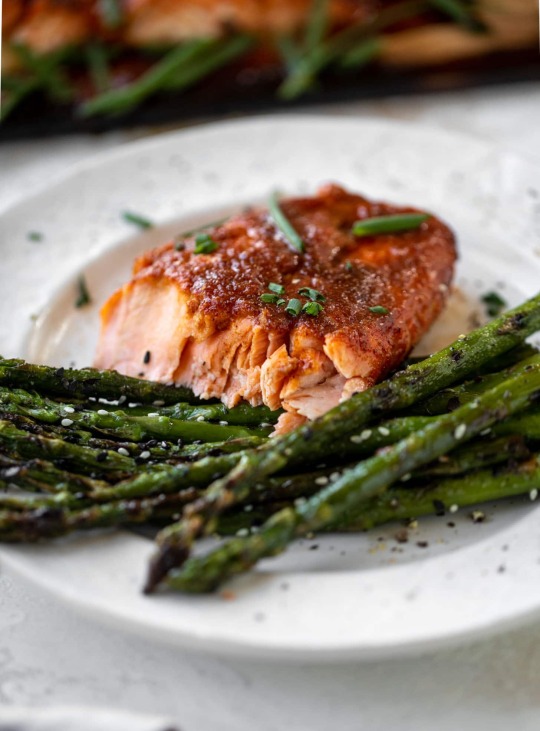
smoky sweet salmon with sesame asparagus · how sweet eats
#smoky sweet salmon with sesame asparagus#smoky sweet salmon#salmon#sesame asparagus#cedar plank salmon#cedar plank#dijon mustard#mustard#brown sugar#smoked paprika#garlic#chives#asparagus#sesame oil#garlic powder#sesame seeds#seafood#fish#food
544 notes
·
View notes
Text

Honey Lemon Chicken and Green Beans
95 notes
·
View notes
Text

20 Minutes Tofu au Paprika Fumé Vegan Avec Riz et Maïs / 20 min Vegan Smoked Paprika Tofu, Rice + Corn
#vegan#lunch#dinner#rice bowl#corn#tofu#paprika#vegan butter#cornstarch#ginger#soy sauce#garlic#shallots#lime#sesame seeds#cilantro#sesame oil#sea salt
91 notes
·
View notes
Text



garlic mustard (alliaria petiolata) is the most invasive little bitch around. not only do the roots exude a chemical that inhibits the growth of other plants, it produces seeds like a MONSTER
i may not be able to win any real battle against this assclown, but i like to do my small part by eating a lot of it. in the spring the young greens are yummy, and the roots have a horseradish taste that’s pretty good. and speaking of seeds…
garlic mustard seeds are a more mild version of yellow or brown mustard seeds, and can be used as a substitute for both. i use it in my pickling spice mix and let me tell you, it is FIRE 🔥
56 notes
·
View notes
Photo

Teriyaki shrimp
#shrimp#seafood#teriyaki#asian food#food#dinner#japanese food#meal#rice#garlic#sesame seeds#soy sauce#green onions#tasty#foodporn#delicious#cooking#food photography#foodgasm#recipe
930 notes
·
View notes
Text

#ENCHANTED FAIRIES HOMES🧚🏻♂️🔼💫
@samirafee
#source: samirafee#own picture#photographers on tumblr#nature#plants#my garden#allium siculum#honey garlic#seed vessel#fairies homes#enchanted#june 2024
51 notes
·
View notes
Text
Discovering the Delight of Hardneck Garlic Near Me
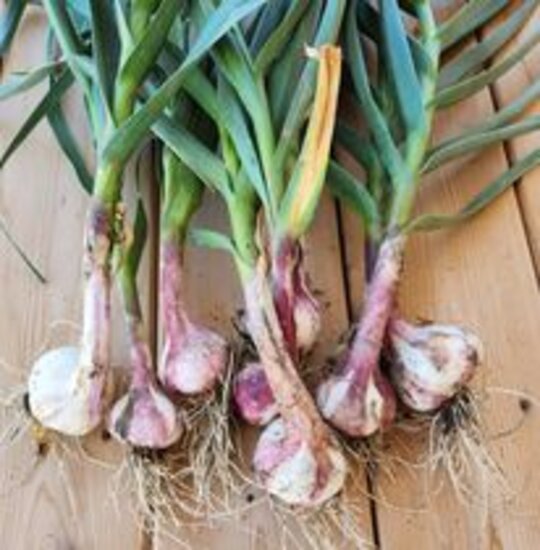
In the crowded and crowded world in the present, as well as the food industry, the need for local, fresh food items is the top priority for those seeking the finest. A popular ingredient that is sought after by consumers is the hardneck garlic. It's a food item that is known for its taste and variety. With growing demands for premium, high-quality ingredients, your search for "hardneck garlic near me" is never more rewarding. Begin with me on a trip to explore the benefits of hardneck garlic, and to discover the most convenient places to find the best varieties in your region.
The Distinctive Charms of Hardneck Garlic
Hardneck garlic is recognized by its thin stem, and distinctive cloves, which differ from softneck in terms of appearance and flavor. It is renowned for its smoky and robust flavor, its rich taste and easy cutting cloves. It imparts flavor and depth to all kinds of food items, from delicious sauces to delicious roasts. The spicy spice is popular with cooks at home as well as chefs and enriches the dining experience due to its distinct flavor.
Why "Hardneck Garlic Near Me"?
In this time of globalization in production of food as well as distribution throughout the world, the importance of buying the ingredients locally can't be overemphasized. If you choose to purchase hardneck garlic that can be grown within your local region, you'll not only help farmers in your area and improve the local economy but you will also get the freshest and delicious garlic accessible. The distance from the farm to the table is significantly shorter and guarantees the best quality and nutritional value.
Where to Find Hardneck Garlic Near You
If you'd like to taste the delicious flavor of garlic that is hardneck There are a variety of options that are available:
Farmers Markets Local farmers markets are bustling centers of commerce for the local community, providing a variety of fresh vegetables and fruits like garlic, which is known as hardneck. Explore the markets, talk to the farmers and pick the most wholesome varieties to spice your dinners.
Community-Supported agriculture (CSA) Programs Signing up to an CSA program allows you to establish a direct connection with farms in the area. It also gives you an ongoing supply of seasonal fresh vegetables and other fruits like garlic, which is a hardneck. When you join an CSA you establish an individual connection with the farmers in your region and are able to access an array of fresh and delicious foods from the farm.
Supermarkets that specialize in specialty foods and cooperatives Specific specialty cooperatives and stores are centered on local production of goods that are made of artisanal materials, like the softneck variety of garlic. Visit those aisles of these stores to find the best range of local delicacies which have been carefully selected to please the most refined taste buds.
U-Pick Farm Stands U-Picks, farms and farm Stands Enjoy the rustic charm of U-pick and farm stand farms in which you can choose the hardneck that you desire right from the farm. Feel the pleasure of picking your fresh vegetables and a feeling of being part of the farm and the people who are working in this farm.
The Art of Cooking using Hardneck Garlic
The abundance of garlic that is available at local vendors, this is the perfect time to let your cooking imagination unleash. If it's cooked until it's caramelized to perfection as well as chopped to make a tasty pesto or blended into delicious oils, the garlic of the hardneck can be used as an ideal base to experiment with your cooking ideas. Its bold flavor and scent can be the base for culinary experiments that transform everyday meals into memorable food moments.
Cultivating a Sustainable Food Future
Alongside its culinary uses it is essential to keep in mind that the decision of examining "hardneck garlic near me" is a crucial decision in the method of food production in the coming decades. In promoting local agriculture and adopting sustainable practices for farming help protect the environment, safeguarding the diversity of the region and encouraging the self-sufficiency of the food we consume. Every purchase of locally grown hardneck garlic an investment in the development of a sustainable, just food system that is based upon sustainability and health for all of the community.
Join the Movement
Are you willing to begin the looking for "hardneck garlic near me" Are you ready to join the growing number of conscious consumers committed to caring for their local farms, and revelling in the simple pleasures of eating fresh farm products. Collectively we can create a healthy, sustainable and sustainable food system that is built on the abundance of our natural landscapes. So, next time you take on a culinary journey be sure to make use of local ingredients, buy fresh and relish the delicious garlic you can get from the hardneck located in that backyard in your house.
To know more about Garlic seed in Manitoba please visit our Website: https://keepdreamin.ca/
Address: 210005 Hwy 519,
Picture Butte, AB
T0K 1V0, Canada
Phone: 403-715-7401
0 notes
Text
Buy Garlic Seeds Ontario | Healthy Cloves Garlic Company
Looking to add some flavor to your garden? Look no further than Healthy Cloves Garlic Company! Our garlic seeds Ontario are the perfect choice for anyone wanting to cultivate their own garlic. With our carefully curated selection of seeds, you'll be on your way to a bountiful harvest in no time. Happy planting!
0 notes
Text
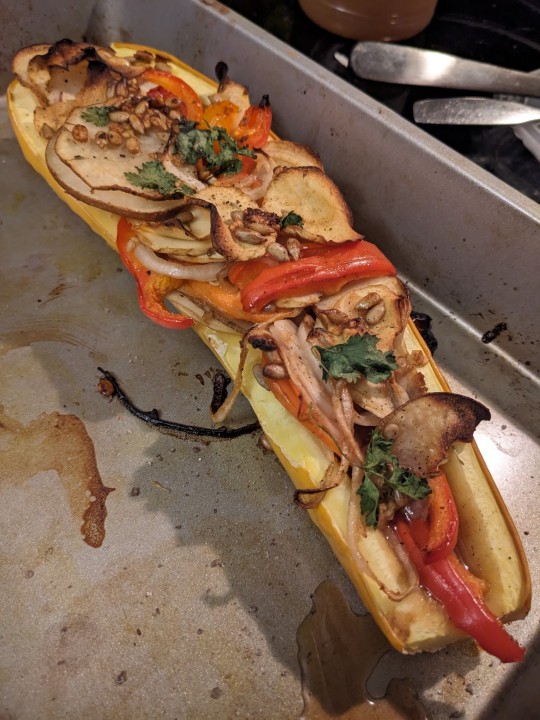
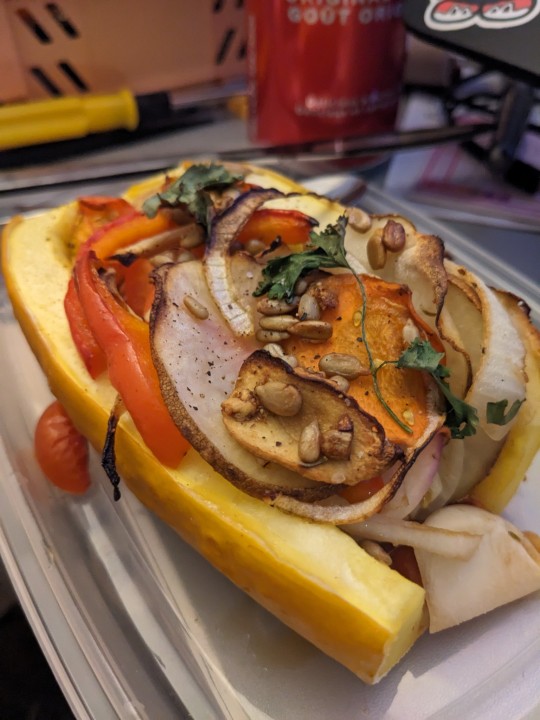
*starts reading dungeon meshi and immediately cooks something nice for the first time in months*
#its just yellow zucchini stuffed with other veggies n garlic n balsamic vinegar#came out tasty#im usually embarrassed to post food pics but im really proud of this#the sunflower seeds added so much tsstiness#ODNT LOOK AT THE PAN ITS UGLY <- thje pan is normal im normal its fine im fine
134 notes
·
View notes
Photo

lemony oregano vegan meatballs · the first mess
#lemony oregano vegan meatballs#vegan meatballs#flax seed#olive oil#onion#garlic#oregano#nutritional yeast#black pepper#walnut#oats#white beans#beans#bean#tamari#lemon zest#parsley#dill#lemon#salad#cucumber#tomato#red onion#hummus#tahini#food#vegetarian#vegan#this
176 notes
·
View notes